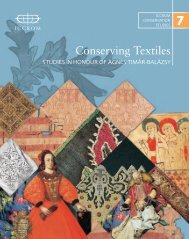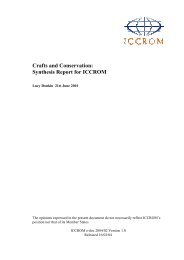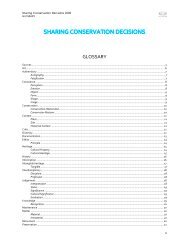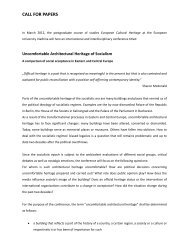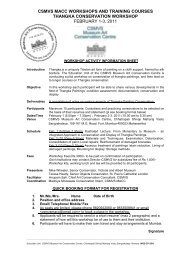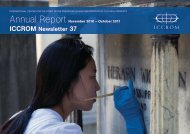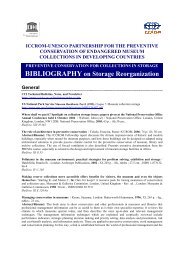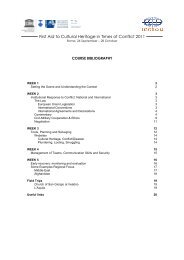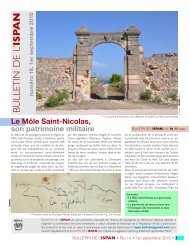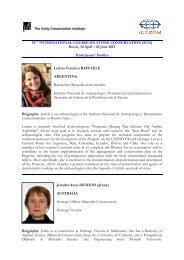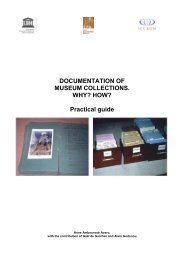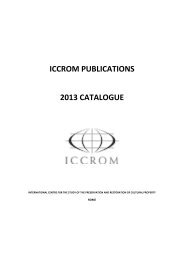part 1 - Iccrom
part 1 - Iccrom
part 1 - Iccrom
You also want an ePaper? Increase the reach of your titles
YUMPU automatically turns print PDFs into web optimized ePapers that Google loves.
MEASURING HERITAGE CONSERVATION PERFORMANCE<br />
6th International Seminar on Urban Conservation<br />
buildings, but for any type of building that might<br />
house collections. Given the specificity of the object<br />
of the research study, a deeper analysis of the history<br />
of the building, the interventions performed<br />
over the years and the state of conservation of the<br />
constructive elements was incorporated into the<br />
work.<br />
2.1. Environmental monitoring<br />
Environmental monitoring includes the collection<br />
and recording of data on environmental parameters<br />
at a <strong>part</strong>icular location, measured in a systematic,<br />
uniform and repetitive way. The collection of longterm<br />
data allows the identification of deterioration<br />
of relations between objects, and their causes, allowing<br />
also verification of the effectiveness of solutions<br />
adopted for the conservation of collections. In the<br />
case of humid tropical climates, one of the main<br />
agents of deterioration is water, whether through<br />
the percolation of moisture from humid soils, the<br />
infiltration of rainwater through the roof vents and<br />
unsealed or high relative humidity. The presence of<br />
moisture in the environment leads to biodegradation<br />
of the construction materials of the buildings<br />
and the matter that constitutes the mobile collections,<br />
especially those of organic character.<br />
The Moorish Pavilion has five habitable floors,<br />
approximately 5,000 square metres of building area<br />
and more than 60 rooms. For the development of<br />
this research project, priority areas to be monitored<br />
were defined: the Entomological Collection, the<br />
Rare Books Library (room collection, room of duplicates<br />
and reading room) and the Exhibition Hall of<br />
the Museum of Life. An external monitoring point<br />
on the east balcony of the building was also set.<br />
To conduct the monitoring, equipment, specifically<br />
data loggers that measure and register the data of<br />
temperature and humidity every hour in each of<br />
the defined points (Figure 4), were used. The minimum<br />
duration of such monitoring should be a year,<br />
so that they can evaluate the environmental characteristics<br />
of the areas in question during all four<br />
seasons, as each one represents changes in temperature,<br />
relative humidity, insulation and incidence of<br />
wind. Taking into account the duration of the study,<br />
the team established an 18 month period of monitoring,<br />
which began in October 2009.<br />
The collected data were gathered monthly and<br />
organized into sheets, with monthly charts produced<br />
for each of the monitored points. From the analysis<br />
of data from relative humidity and temperature<br />
collected, and the issues raised by the conservation<br />
assessment of the collections, it will be possible to<br />
assess the conservation impact of environmental<br />
conditions where these collections are housed.<br />
Despite that the evaluation stage of monitoring<br />
data is not yet complete, preliminary analysis<br />
of data already allows some considerations to be<br />
made. In the case of the Library, the evaluation of<br />
monitoring data indicated that the existing climate<br />
control system, although designed to ensure conditions<br />
for the conservation of the collection, has been<br />
unable to properly maintain the stability in relation<br />
to relative humidity in the environment of collection.<br />
At times, there is a variation of more than ten<br />
percentage points in 24 hours, and also some peaks<br />
above 65% RH, the value at which the materials,<br />
especially those of organic base, are more susceptible<br />
to biodegradation.<br />
Figure 4. Monitoring equipment installed at Moorish Pavilion – 2 nd and 3 rd floors (Source: De<strong>part</strong>amento de<br />
Patrimônio Histórico/COC/Fiocruz).<br />
Teixeira Coelho, A. M. & .C. S. Rodrigues de Carvalho. 2012. The conservation assessment as a tool for cultural heritage identification,<br />
monitoring, and evaluation. In Zancheti, S. M. & K. Similä, eds. Measuring heritage conservation performance, pp. 82-89. Rome, ICCROM.<br />
86



